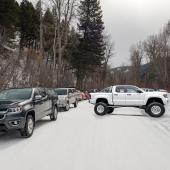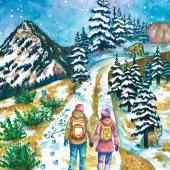Trails to Nowhere
Urban trails may get overlooked, but they help us thrive by offering opportunities for recreation, alternative transportation, and a higher quality of life. It seems trails ought to be a key part of the valley’s infrastructure, but more often they are only an afterthought. Consequently we have a haphazard collection of dead-end, unused trails scattered throughout the county.
The county is working to improve local parks and trails planning. An effort is currently underway to revise the Trails Plan, for example, in order to address a more interconnected system. The main goal is to link important community resources like parks, schools, trailheads, subdivisions, and even neighboring towns with trails. An inventory of all existing parks and trails is underway and public surveys, outreach work, as well as GIS mapping and modeling are assessing area needs. A draft plan should be available for public comment this year.
County and city authorities create trails with the same limited resources needed for things like wastewater treatment, jails, libraries, and roads. That's why most trail creation and maintenance is often left to hard-working nonprofits. A shining example is the Gallatin Valley Land Trust, which established the popular Main-Street-to-the-Mountains system and could not have done so without generous help from citizens.
In Montana, cities and counties can require developers to build trails in subdivisions. The Gallatin County Trails Plan, written by committed residents in 2001, recommends key connections that should be built, including a Belgrade-to-Bozeman corridor and one linking Bozeman to the “M.” The plan, however, is not regulatory and can therefore only advise decision makers. In addition, it does not include parks or an interconnected system of trails. The county has no comprehensive plan for such a network or how it should function. As a result, very few of the lovable kind of urban trails are created. Those that are created usually end up as random stubs that dead-end into nowhere.
Like a worthy friend, a trails system can offer invaluable solutions to life’s daily struggles. It can alleviate traffic congestion, improve air and water quality, ensure safety, promote healthy living, preserve and create open spaces, protect important habitats, increase property values, and much more. For additional information, contact the Gallatin County Planning Department at 582-3130.
Responsible Trail Use
This issue is controversial, but everyone should know what is acceptable during spring and what causes a trail to be destroyed and possibly closed. Art Tuftee, a professional trail consultant in Seattle, has one big piece of advice for riders (advice you can also apply to the other rough trails in your life): don't go around it, go through it. Instead of going around the snow, go through it or get off and walk through it. Spring is a fragile time, and when trails are snow-covered most users will start to create their own trails to avoid the snow. This causes braiding, which describes a trail with two or three different trails stemming from it. The same applies for mud-covered trails. If you must be on the trail, then go through the mud and realize that trying to stay clean is not going to happen, it’s spring. Although going through the mud will cause ruts that may never smooth out, going around the mud/snow causes erosion and wrecks new vegetation. —Hallie Zolynski











